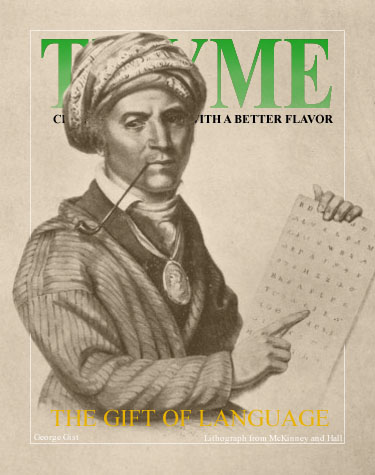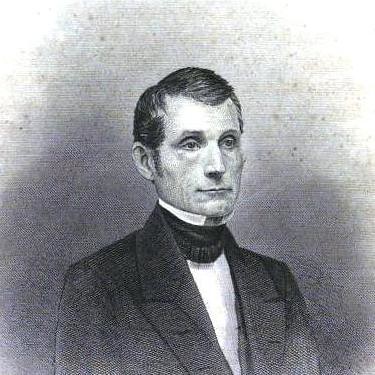
Volume VIII, Issue IX
The Gift of Language
How Sequoyah Gave His People Written Words
Perhaps the most remarkable man who has ever lived on Georgia soil was neither a politician, nor a soldier, nor an ecclesiastic, nor a scholar, but merely a Cherokee Indian of mixed blood. And strange to say, this Indian acquired permanent fame, neither expecting or seeking it." -- H. A. Scomp, Emory College
He was hardly someone you would predict would create such a significant contribution to his nation. George Gist was born to a Cherokee mother, Wu-teh, a member of the Paint Clan, and Nathanial Gist, an English fur trader near the village of Tushkeegee on the Tennessee River. The year was around 1760 but no one knows for sure. Learning the ways of the Cherokee, young George became a trapper and a fur trader himself. He would probably have lived out his days as a man of the forest, but he suffered a hunting accident (or possibly succumbed to a crippling disease, depending on which version of his story you read), but the young man was permanently disabled, unable to earn his living by the skills he had been taught in childhood.
George Gist developed a talent for metal working. He learned to be a blacksmith and silversmith. His disability became both a source of ridicule (Sequoyah means "pig's foot" in Cherokee) and a spur to greater things. The man was a good learner and became a competent craftsman. A man who purchased one of his pieces suggested that he sign his work, but he was unable to. He could not write! And here as well his story might have ended, but events in the greater world were to spur him to his greatest work. Sequoyah married a Cherokee woman and raised a family. They moved to Cherokee County in Georgia where George learned how to write his name from a local farmer. Later he joined other Cherokees who fought under Andrew Jackson against England in the War of 1812. Though he never learned to read or write English, Sequoyah was fascinated by the white man's ability to create "talking leaves" by making marks on paper.
As early as 1809, Sequoyah was exploring the creation of a Cherokee alphabet. Though scholars believe there may have once been a written Cherokee language that was later forgotten, there was no written Cherokee language when Sequoyah was a youth. People suspected that the white man's words "moved around on the paper," and the time was right for Cherokee to be able to read things for themselves. Cherokee soldiers could not write letters home, read military orders for themselves, or record events they wished to remember. When he returned home from the war, he worked in earnest on a phonetic alphabet of 86 letters to write the Cherokee Language. Sequoyah became something of a recluse. His friends and family ridiculed him. Some said he was insane or practicing witchcraft. Moving West to Arkansas, he continued his great work.
He found that his young daughter Ayoka could easily learn to use the syllabary and demonstrated this to his cousin, George Lowrey, who encouraged him to demonstrate the use of the syllabary to the public. In a Cherokee court case in Chattooga, he read an argument about a boundary line from a piece of paper. In 1821 the Cherokee Nation officially adopted Sequoya's alphabet and within a matter of months thousands of Cherokee learned to read and write! In 1824 the Cherokee National Council at New Echota, Georgia presented him with a silver medal. Sequoyah proudly wore it for the rest of his life. He was given a $300 annuity and his widow continued to receive it after he died.
By 1825 the Cherokee had the Bible in their own language along with hymnals and all sorts of educational materials. There was even a large group of Moravian Cherokee. Legal documents and books of every kind were available, all translated into the Cherokee Language. In 1827 The Cherokee National Council funded the printing of Tsa la gi Tsu lehesanunhi," the Cherokee Phoenix. It was the first Native American newspaper printed in the United States. It was produced in the Cherokee Capital, New Echota on a press shipped there from Boston. The paper had parallel columns in Cherokee and English, printed side by side.
Sadly, the discovery of gold in North Georgia, unscrupulous men and treachery in treaty would lead to the removal of most of the Eastern nation. Sequoyah moved to Oklahoma were he served as an envoy to Washington D.C. to assist the displaced Eastern Cherokees. He continued to serve his people as a diplomat and a statesman. Well into his eighties, he traveled West again, looking for a band of Cherokees who were said to have moved to Mexico. He took ill and died in 1843 and the location of his grave remains unknown to this day. Two species of giant redwood trees have been named in his honor, as has Sequoia National Park in California. He gave his people the gift of literacy. His contribution is unique, as he, an uneducated, seemingly undistinguished individual, created a totally new system of writing for his beloved nation. [1.]
J. Lanphier's Journey of Prayer
How A Nation Was Turned to G-d and Restored

Jeremiah Lanphier discovered the power of prayer in his own life.
By the middle of the Nineteenth Century, America found herself at a crossroads. Wild speculation and greed had built a house of cards. While a few became incredibly wealthy, the gap between haves and have-nots grew ever wider. The economic crash had put 30,000 men out of work on the streets of New York City. Churches languished as people explored Spiritism and other "new" ideas. We, of the Twenty-first Century, would find the condition of the culture strangely familiar.
Political corruption, shady dealings in business and a general moral decline were the norm. "Atheism, agnosticism, apathy and indifference to God, to the church, and its message abounded on every hand. The decline was fourfold: social, moral, political and spiritual." -- Tom Shanklin
Then came the crash! Factories were shuttered. Banks failed and merchants were ruined. Thousands were destitute. Winkie Pratney, who chronicled the great revival, says: "A near socio-economic collapse jolted America away from her apathy into a national cry for spiritual reality." Chuck Balsamo presents a wonderful concise history of this revival in his book Make Me a Legend [click to read]. The story does not begin with a mighty move and thousands of conversions, rather it begins in a rather small way.
Jeremiah Lanphier was a middle-aged businessman caught in the crossroads. Having no children and no family, he was drawn to minister to the needs of those living in the dark slums of Hell's Kitchen. Leaving his business, he became a lay missionary with the North Dutch Church in Manhattan. Pouring his life into the lives of those he saw caught in hopelessness, he soon came to the end of his own strength. Physically and mentally exhausted, Lanphier discovered that just as the body needs food, the soul and spirit of a man need to be nourished in prayer.[1.]
Each day at midday, Lanphier would seek solace in the Church Consistory Building, where he would cry out to G-d for spiritual strength. He experienced G-d in a mighty way in these times and felt that others would benefit from prayer as well, especially the city's businessmen. He printed up and distributed 20,000 flyers advertising his first noontime prayer meeting, on September 23, 1857.
That day he prayed alone for thirty minutes before six others joined him. The next week there were twenty. The week after that forty people showed up. In time over 100 churches had noonday prayer meetings going throughout the city. G-d's powerful move was felt far beyond New York City. Newspaperman Horace Greeley wanted to get a count of the number of men praying in New York so he sent a reporter out to the meetings. Racing around the city in a horse-drawn buggy, the reporter was only able to get to twelve meetings in the noon hour, but he counted 6,100 in attendance.
Spiritual awakening followed and Americans found strength in G-d for the turbulent days that followed. This Third Great Awakening not only revitalized the spirit of America's people, but led to missionary outreach around the world. [2.]




No comments:
Post a Comment